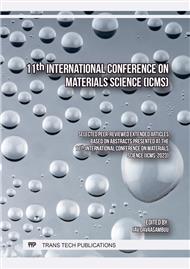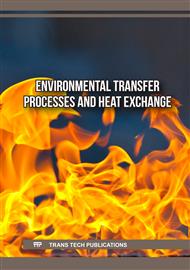[1]
Gschneidner K A Jr, Pecharsky V K, Tsokol A O, Recent developments in magnetocaloric materials, Rep. Prog. Phys, 68 (2005) 1479-1539.
DOI: 10.1088/0034-4885/68/6/r04
Google Scholar
[2]
Bruck E, Tegus O, Thanh D T C, Buschow K H J,Magnetocaloric refrigeration near room temperature (invited), J. Magn. Magn. Mater. 310(2007) 2793-2799.
DOI: 10.1016/j.jmmm.2006.10.1146
Google Scholar
[3]
Li G J, Li W, Stephan S, Li X Q, Delczeg-Czirjak E.K, Yaroslav O.K, Olle E, Börje J, Levente V, Kinetic arrest induced antiferromagnetic order in hexagonal FeMnP0.75Si0.25 alloy, Appl. Phys. Lett.105 (2014) 262405.
DOI: 10.1063/1.4905270
Google Scholar
[4]
Annaorazov M P, Nikitin S A, Tyurin A L, Asatryan K A, Dovletvo A K, Anomalously high entropy change in FeRh alloy, J. Appl. Phys.79 (1996) 1689.
DOI: 10.1063/1.360955
Google Scholar
[5]
Pecharsky V K, Gschneidner K A Jr, Giant Magnetocaloric Effect in Gd5(Si2Ge2),Phys. Rev. Lett.78(1997) 4494-4497.
DOI: 10.1016/s0304-8853(96)00759-7
Google Scholar
[6]
Fujita A, Fujieda S, Hasegawa Y, Fukamichi K, Itinerant-electron metamagnetic transition and large magnetocaloric effects in La(FexSi1-x)3 compounds and their hydrides, Phys. Rev. B 67 (2003) 104416.
DOI: 10.1063/1.1498148
Google Scholar
[7]
Hai X Y, Mayer C, Colin C V, Miraglia S,In-situ neutron investigation of hydrogen absorption kinetics in La(FexSi1-x)3 magnetocaloric alloys for room-temperature refrigeration application, J. Magn. Magn. Mater. 400 (2016) 344-348.
DOI: 10.1016/j.jmmm.2015.07.018
Google Scholar
[8]
Tegus O, Bruck E, Buschow K H J, de Boer F R, Transition-metal-based magnetic refrigerants for room-temperature applications, Nature. 415 (2002) 150-152.
DOI: 10.1038/415150a
Google Scholar
[9]
Nguyen H. Dung , Zhi Qiang Ou , Luana Caron , Lian Zhang , Dinh T. Cam Thanh , Gilles A. de Wijs, Rob A. de Groot, K. H. Jürgen Buschow and Ekkes Brück, Mixed Magnetism for Refrigeration and Energy Conversion, Advanced Energy Materials 1 (2011) 1215-1219.
DOI: 10.1002/aenm.201100252
Google Scholar
[10]
Kudryavtsev Y V, Uvarov N.V, Iermolenko V N, Glavatskyy I N, Dubowik J,Electronic structure, magnetic and optical properties of Heusler alloy, Acta Mater 60 (2012) 4780-4786.
DOI: 10.1016/j.actamat.2012.05.031
Google Scholar
[11]
Guillou F, Ollefs K, Wilhelm F, Rogalev A, Electronic and magnetic properties of phosphorus across the first-order ferromagnetic transition of (Mn,Fe)2(P,Si,B) giant magnetocaloric materials, Phys. Rev. B 92 (2015) 224427.
DOI: 10.1103/physrevb.92.224427
Google Scholar
[12]
F. Guillou, Sun-Liting, O. Haschuluu, Z.Q. Ou, E. Brück, O. Tegus, H. Yibole, Room temperature magnetic anisotropy in Fe2P-type transition metal based alloys, J. Alloys Compd. 800 (2019) 403-411.
DOI: 10.1016/j.jallcom.2019.05.327
Google Scholar
[13]
Z.Q.Ou, N.H. Dung, L.Zhang, L.Caron, E.Torun, N.H.van Dijk, O.Tegus,E.Bruck, Transition metal substitution in Fe2P-based MnFe0.95P0.50Si0.50 magnetocaloric compounds, Journal of Alloys and Compounds, J. Alloys Compd. 730 (2018)392-398.
DOI: 10.1016/j.jallcom.2017.09.315
Google Scholar
[14]
Yingjie L, B Huliyageqi, W Haschaolu, ZhiqiangSong, O Tegus, IkuoNakai, EXAFS study of Mn1.28Fe0.67P0.46Si0.54 compound with first-order phase transition, J. Electron. Spectrosc. relat. phenom. 46212(2014) 104-109.
DOI: 10.1016/j.elspec.2013.12.006
Google Scholar
[15]
Shuang Ma, B.Wurentuya, Xiaoxia Wu,Yongjing Jiang, O.Tegus,Pengfei Guan, and B.Narsu , Ab initio mechanical and thermal properties of FeMnP1-xGax compounds as refrigerant for room-temperature magnetic refrigeration, RSC Adv. 7 (2017)27454-27463.
DOI: 10.1039/c7ra04274d
Google Scholar
[16]
B. Wurentuya,M.Shuang,B. Narsu,O.Tegus,Zhidong Zhang, Lattice Dynamics of FeMnP0.5Si0.5 Compound from First Principles Calculation, J. Mater. Sci. Technol. 35(1) (2019) 127-133.
DOI: 10.1016/j.jmst.2018.09.009
Google Scholar
[17]
Roy P, Torun E, de Groot R A, Effect of doping and elastic properties in (Mn,Fe)2(Si,P), Phys. Rev. B 93 (2016) 094110.
Google Scholar
[18]
Chao Jiang, B.P. Uberuaga, S.G. Srinivasan, Point defect thermodynamics and diffusion in Fe3C: A first-principles study, Acta Mater. 56 (2008) 3236-3244.
DOI: 10.1016/j.actamat.2008.03.012
Google Scholar
[19]
C. Jiang, D.J. Sordelet, B. Gleeson, Site preference of ternary alloying elements in Ni3Al: A first-principles study, Acta Mater. 54 (2006) 1147-1154.
DOI: 10.1016/j.actamat.2005.10.039
Google Scholar
[20]
Chao Jiang, First-principles study of site occupancy of dilute 3d, 4d and 5d transition metal solutes in L10-TiAl. Acta Mater. 56 (2008) 6224-6231.
DOI: 10.1016/j.actamat.2008.08.047
Google Scholar
[21]
Huijin TAO, Shan ZHOU, Yu LIU, Jian YIN, Hao XU. Point Defect Concentrations and Interactions in D019-Ti3Al from First-Principles Calculations[J]. Acta Metall Sin, 53 (6) (2017,): 751-759.
Google Scholar



